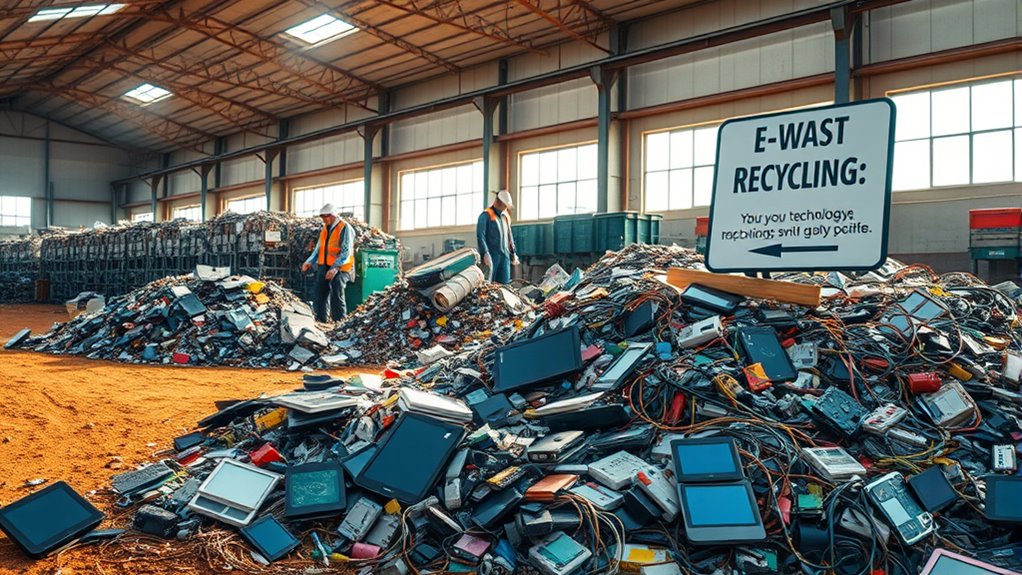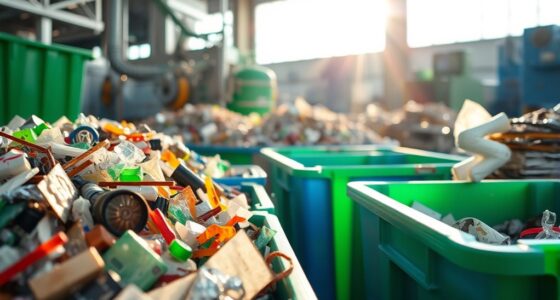Ethical technology requires you to manage e-waste responsibly. As devices become obsolete quickly, they can harm the environment with hazardous materials like lead and mercury. By participating in recycling programs and using manufacturer take-back initiatives, you guarantee safe handling of toxic substances. Extending device lifespans through refurbishment and donation promotes reuse, reducing the demand for new products. Plus, being aware of local regulations helps you make informed decisions. There’s more to learn about fostering sustainable technology practices.
Key Takeaways
- E-waste contains hazardous materials that can harm the environment if not disposed of properly, highlighting the need for responsible disposal practices.
- Participating in manufacturer take-back programs ensures safe handling of e-waste and contributes to resource recovery through recycling.
- Refurbishing and donating old devices extends their lifespan, reducing the demand for new products and minimizing manufacturing impacts.
- Awareness of local e-waste disposal regulations empowers individuals to make environmentally responsible decisions regarding their electronics.
- Making informed choices about device disposal and recycling fosters a culture of ethical technology use and supports sustainability efforts.

How can technology be both innovative and ethical? This question lies at the heart of our relationship with the devices and systems we use every day. As you embrace new technologies, it is crucial to consider the impact they have not only on your life but also on the environment. One pressing issue that often gets overlooked is e-waste and responsible disposal. With the rapid pace of innovation, electronic devices become obsolete faster than ever, creating a growing mountain of waste that can harm the planet.
When you upgrade your smartphone or replace your laptop, what happens to the old device? Many people toss them into the trash, unaware of the environmental consequences. E-waste contains hazardous materials like lead, mercury, and cadmium, which can leach into soil and waterways, causing considerable ecological damage. The good news is that you can make a difference by being mindful of your disposal choices.
Instead of throwing away unwanted electronics, you should look into recycling programs. Many manufacturers and retailers have take-back initiatives that allow you to return old devices for proper recycling. By participating in these programs, you’re not only ensuring that toxic materials are safely handled, but you’re also helping recover valuable resources that can be reused in new products. This closes the loop, making technology more sustainable and less harmful to our planet.
You might also think about refurbishing your devices. If your old laptop still has some life left in it, donating it to a local charity or school can provide others with access to technology they otherwise might not afford. By extending the lifespan of electronic devices, you’re promoting a culture of reuse and reducing the demand for new products, which in turn diminishes the environmental impact of manufacturing.
In your journey toward ethical technology, awareness is key. Familiarize yourself with laws and regulations regarding e-waste in your area, as these can vary considerably. Knowing how to properly dispose of or recycle electronics empowers you to take action. Additionally, just as with bicycle maintenance, regular inspections can help identify devices that may be suitable for repair or recycling before they become waste.
Ultimately, you have the power to shape the future of technology by choosing responsible disposal methods. By making informed decisions, you can contribute to a more sustainable world, ensuring that innovation and ethics go hand in hand. It’s time to embrace technology not just as a tool but as a responsibility we all share.
Frequently Asked Questions
What Are the Environmental Impacts of Improper E-Waste Disposal?
Improper e-waste disposal harms the environment profoundly. When you discard electronics irresponsibly, toxic substances like lead, mercury, and cadmium can leach into soil and water, contaminating ecosystems. This pollution threatens wildlife and can enter the food chain, affecting human health. Additionally, valuable resources in e-waste, like metals, go to waste instead of being recycled. By properly disposing of e-waste, you help reduce these harmful impacts and promote a healthier planet for everyone.
How Can I Find Local E-Waste Recycling Centers?
To find local e-waste recycling centers, start by searching online with terms like “e-waste recycling near me.” You can check websites like Earth911 or your local government’s environmental department for resources. Many electronics retailers also offer recycling programs. Don’t forget to ask friends or community groups for recommendations. Once you’ve found a center, confirm their accepted items and drop-off times to make sure your e-waste is disposed of responsibly.
What Are the Regulations Surrounding E-Waste in My Area?
You’ve got to know that e-waste regulations can feel like a labyrinth! In your area, laws typically require you to recycle electronics through certified facilities. Many states ban regular trash disposal of hazardous materials found in e-waste. Check with your local government or environmental agency for detailed guidelines. You can also find resources online that outline specific regulations applicable to your location. Stay informed and help protect the environment!
Can I Donate Old Electronics Instead of Recycling?
Yes, you can donate old electronics instead of recycling them! Many organizations, like schools or charities, appreciate working devices. Be sure to check if the items are in good condition and still useful. Before donating, erase any personal data to protect your privacy. Keep in mind, some places might have specific guidelines for donations, so it’s a good idea to call ahead and confirm what they accept. Your old tech can help others!
What Happens to E-Waste After It Is Recycled?
After e-waste is recycled, it’s processed to recover valuable materials like metals, plastics, and glass. These materials are sorted, cleaned, and prepared for reuse in new products. Some components might be refurbished or repurposed, while hazardous substances are safely disposed of to prevent environmental harm. By recycling your old electronics, you help reduce landfill waste and conserve natural resources, contributing to a more sustainable future for everyone.
Conclusion
As you reflect on the impact of e-waste, consider what happens to your discarded gadgets. Are they languishing in landfills, leaching toxins into the earth? Or are they being responsibly recycled, perhaps transformed into something new? The choice is yours. By making informed decisions about your tech disposal, you hold the power to shape a sustainable future. So, what will you do next time you upgrade? The clock’s ticking—your actions today can spark a change tomorrow.









